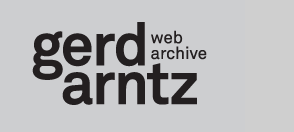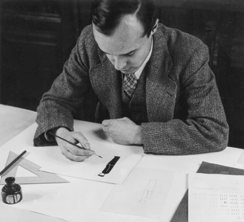
Gerd Arntz draws the Isotype symbol for 'unemployed'.
Collection: Peter Arntz
Unique (Dutch) sound fragment:
Interview with Gerd Arntz by Djoeke Veeninga, VPRO, August 6th, 1976.
Collection: Kees Slager
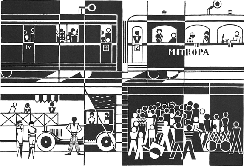
Mitropa, 1925
This was one of Arntz’s prints which Neurath saw in 1926, and which convinced him that this artist, with his trimmed down realism, was just the man for him.
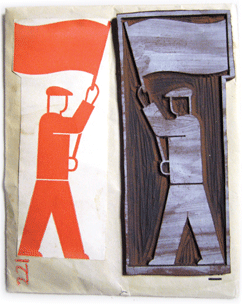
Linoleum-cut and print of an Isotype symbol by Gerd Arntz, 1930’s, from
the Arntz archive, now at the Municipal Museum, The Hague. The original
linos show the precision of the craft work in the expressive traces of
the gouge. The prints next to them are proofs made by Arntz.
Photo: Max Bruinsma
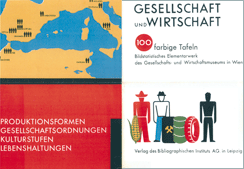
The original cover of the atlas Gesellschaft und Wirtschaft.
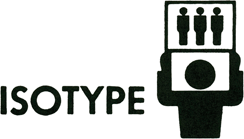
Isotype logo.

The generic symbol for ‘man’ acquires a specific content.
Gerd Arntz (1900-1988)
Already as a young man, born in a German family of traders and manufacturers, Gerd Arntz was a socially inspired and politically committed artist. In Düsseldorf, where he lived since his nineteenth, he joined a movement which wanted to turn Germany into a ‘soviet-’ or ‘council republic’, a radically socialist state form based on direct popular democracy. As a revolutionary artist, Arntz was connected to the Cologne based ‘progressive artists group’ (Gruppe progressiver Künstler Köln) and depicted the life of workers and the class struggle in abstracted figures on woodcuts. Published in leftist magazines, his work was noticed by Otto Neurath, a social scientist and founder of the Museum of Society and Economy (Gesellschafts- und Wirtschaftsmuseum) in Vienna, Austria. Neurath had developed a method to communicate complex information on society, economy and politics in simple images. For his ‘Vienna method of visual statistics’, he needed a designer who could make elementary signs, pictograms that could summarize a subject at a glance.
Arntz’s clear-cut style suited Neurath’s goals perfectly, and so he invited the young artists to come to Vienna in 1928, and work on further developing his method, later known as ISOTYPE, International System Of TYpographic Picture Education. During his career, Arntz designed around 4000 different pictograms and abstracted illustrations for this system. At the same time, he was working with Neurath and his collaborators on designing exhibitions and publications for the Vienna museum. In this time, the 1930s, the city was under socialist government and an internationally acclaimed center of social housing and workers’ emancipation. Neurath’s visual statistics were adamantly meant as being an instrument of this emancipation, and Arntz’ own socialist background fitted this context seamlessly.
Produced under Arntz’s creative guidance, a collection of 100 visual statistics, ‘Gesellschaft und Wirtschaft’, was published in 1930. The success of this collection lead among other things to an invitation to come to the young Soviet Union and set up an institute for visual statistics, Isostat, in Moscow. Neurath and Arntz regularly traveled to Moscow in the 1930s, until in 1934 the socialist government of Vienna fell. After the Nazi take over, both emigrated with their families to the Netherlands, where they continued working on Isotype in The Hague. When the second world war broke out, Neurath fled to England. Arntz stayed in The Hague, where he worked for the Dutch Foundation of Statistics.
Arntz’ artistic legacy is administered by the Municipal Museum of The Hague, and a generous selection of his work from this collection is now available on-line for the first time.
Activism
In his early twenties, the young German artist Gerd Arntz said goodbye to his bourgeois background and committed himself to the struggle of the underprivileged workers. During an artistic career spanning 50 years, he has continually criticized social inequality, exploitation and war in clear-cut prints – activism with artistic means.
In Düsseldorf, Arntz attended an art academy in the early 1920s to become a drawing teacher. There, he frequented revolutionary circles, rebel minds who wanted to turn Weimar Germany into a ‘soviet republic’, styled after early communist Russia. He also came into contact with the new movements in the arts at the time, such as expressionism and constructivism. For activist artists like Arntz, the wood-cut was the chosen medium, because of its ‘primitive’ aspect and its clearblack-and-white contrast. In the 1930s, Arntz switched to linoleum-cuts.
With his comrades, the Cologne artists Franz Seiwert and Heinrich Hoerle, he read Marxist and anarchist literature and developed his own style of portraying society as segregated in classes, struggling within the technological milieu of the modern city. His prints were exhibited, sold to sympathetic art lovers, and published in magazines of the activist left in Germany and abroad.
When Arntz was asked by Otto Neurath to join his team at he Vienna Museum of Society and Economy, and develop Isotype, he took it as an opportunity to expand the reach of his political beliefs into the realm of actively informing the proletariat, albeit as a graphic designer. At he same time, this steady job provided him the means to continue his own artistic work, completely independent of the art market or political affiliations. His prints criticizing the capitalist system did, for instance, not prevent him from critically looking at the downside of the Soviet Union in other prints.
After he emigrated to the Netherlands, in 1934, Arntz published a series of prints warning against the danger of Nazism. His concise and biting depiction of the build-up of the ‘Third Reich’, published in a Dutch communist magazine in 1936, was removed from an exhibition in Amsterdam after complaints by the German embassy that it insulted a ‘friendly head of state’.
Arntz continued cutting his social and political critique into linoleum until he was seventy years old.
Isotype
The International System Of TYpographic Picture Education was developed by the Viennese social scientist and philosopher Otto Neurath (1882-1945) as a method for visual statistics. Gerd Arntz was the designer tasked with making Isotype’s pictograms and visual signs. Eventually, Arntz designed around 4000 such signs, which symbolized keydata from industry, demographics, politics and economy. Otto Neurath saw that the proletariat, which until then had been virtually illiterate, were emancipating, stimulated by socialism. For their advancement, they needed knowledge of the world around them. This knowledge should not be shrined in opaque scientific language, but directly illustrated in straightforward images and a clear structure, also for people who could not, or hardly, read. Another outspoken goal of this method of visual statistics was to overcome barriers of language and culture, and to be universally understood. The pictograms designed by Arntz were systematically employed, in combination with stylized maps and diagrams. Neurath and Arntz made extensive collections of visual statistics in this manner, and their system became a world-wide emulated example of what we now term: infographics.
Standardization
Apart from being the acronym of ‘International System Of TYpographicPicture Education, isotype is also Greek for ‘the same sign’. This last meaning summarizes the essence of the system: standardization. By developing a standard for the way in which information is represented visually, Neurath changes a style of illustration into a coherent visual language, providing strict rules for making ‘visual texts’. Because of this standardization, generic symbols (‘man’, for instance) can, by means of small variations or additions (such as a cap or standardized signs for various industries) acquire a specific content (‘worker in the steel industry’). This way also, various data become comparable.
Images
The Isotype symbols were not meant to completely replace words, but to summarize and support the verbal content of the statistics. Due to this visual summary, less text is needed as well – the images give the relations, so that the text can be limited to key words instead of sentences. Important for the overview is the way in which the symbols are employed within the page’s grid. Here too, simplicity rules: horizontal arrangement represents changes in quantities, while vertical arrangement shows a passage of time or a comparison between various data. An accompanying illustration (Führungsbild) sometimes appears in the background of these infographics to enliven the composition and to add a geographical or content-related connotation.
Science
Many of Neurath’s contemporaries rendered proportions by varying the size of their symbols. But according to Neurath’s Isotype rules, more or less are not represented by bigger or smaller symbols, but by more or less symbols, each symbol representing a specific amount. In this manner, relations can be read more easily and exactly. In his representation, Neurath as it were gives the ruler, which is absent in other methods.
Simplification
Gerd Arntz, commissioned by Otto Neurath, developed the Isotype visual dictionary, consisting of over 4000 symbols. The idea was that images can bridge differences of language, are easy to grasp and, when done well, also nice to look at. The legibility of Isotype is determined by the simplicity of its symbols. These should be instantly recognizable,without any distracting detail. What counts is the general idea – for common use the precise details are of less importance. Or in Neurath’swords: ‘It is better to remember simplified images, than to forget exact figures.’
Gerd Arntz drew more than 4000 ‘signatures’ (pictograms or small illustrations) for Isotype to be used in visual statistics. Not all of these pictograms are reproduced on this website – we have made a representative selection of around 600 figures. This is also because the collection contains quite a few variants of the same or similar pictograms, since for each different size a separate linocut had to be made by hand. The same goes for each outline, fill or half-tone, while some pictograms are printed in different colors.
The pictograms and small illustrations shown on this website are scanned from the original prints in the Arntz archive of the Municipal Museum The Hague. This accounts for some irregularities, which resulted from hand printing the linocuts. Our only intervention concerns the background (usually brown or brownish paper) which was whitened by Ontwerpwerk to emphasize the contours of the drawings, whilst keeping the authenticity of the outlines intact.
The categories on this website are not ones Gerd Arntz used himself. We have grouped the various pictograms in a limited number of categories to enable the visitor to see them in context, to compare and contrast similar forms and subjects and to narrow your search.The filenames of the Isotypes are the ones under which the digital versions of the prints are archived in the Municipal Museum The Hague.
Statistics
The atlas Gesellschaft und Wirtschaft – Bildstatistisches Elementarwerk is a loose-leaf collection printed and published in Leipzig, 1930, and issued by Otto Neurath’s eponymous museum in Vienna. Together, the 100 visual charts, in Gerd Arntz’s austere design, provide an overview of the essential empirical data of the world at that time.
The atlas is a text book example of the ‘Vienna method’ to present generally accessible information regardless of language barriers with the aid of images. Neurath and Arntz further developed their method in the 1930s into Isotype.
The atlas is their major collection of visual statistics, and was used as Elementarwerk, meaning as an example of how to make complex information accessible, using a standardized visual language.
The 100 charts conjure up an image of populations of countries and continents, of world powers and their political and military relations, of trade and industry, the growth of cities and their social structure and workers’ conditions. Everything is orderly visualized in directly recognizable diagrams.
As a model for visual statistics, the atlas was a success. In 1931, Neurath and Arntz were invited to apply their method in a new institute for visual statistics in the Soviet Union: Isostat. Neurath also acquired commissions form other European countries and the United States, where his pupil Rudolph Modley started a similar institute.
Neurath and Arntz are also the fathers of the Dutch field of visual statistics, which they developed after their emigration to Holland in 1934, in their The Hague based Foundation for Visual Education. Neurath left again in 1940, this time for England, where he set up the Isotype Foundation and continued to work until his death in 1945. Arntz stayed in The Hague, and worked on Neurath’s legacy in the Foundation for Statistics, after the war.
